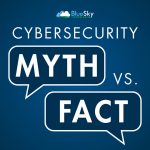 You wouldn't drive without a seatbelt. You wouldn't leave your office unlocked overnight. So why go online without multifactor authentication (MFA)?
You wouldn't drive without a seatbelt. You wouldn't leave your office unlocked overnight. So why go online without multifactor authentication (MFA)?
Multifactor authentication (MFA) acts as an extra lock on your digital door. Rather than relying solely on a password, which can be stolen, guessed, or obtained through phishing, MFA adds a layer of protection, typically in the form of a text code, an authentication app, or a fingerprint scan. If a hacker manages to get your password, they'll hit a dead end without completing the MFA steps.
One Extra Step Can Make All The Difference
Think of your password as locking your front door. MFA is the security system you arm before heading to bed. It's not mandatory, but it's a smart safeguard to have if one protection fails.
MFA simply adds a short extra step to confirm that it's really you logging in. You may hear it called two-factor authentication, two-step authentication, or one-time password, but it all means the same thing: verifying your identity in more than one way before access is granted.
Common examples include:
- Confirmation emails when creating or logging into an account
- Security questions or PINs
- Text message or app-based codes
- Push notifications or phone calls
Most of these take only a tap or two, and that small effort goes a long way toward protecting your data.
How MFA Stops Hackers
For you, MFA is quite simple. All you have to do is click a button or enter a code to approve a login, and you're done. However, for a hacker, it's a major roadblock.
If someone tries to log in to your account without permission, MFA sends you an alert or requires that extra code. That early warning gives you a chance to reset your password before damage is done.
Even if a hacker tricks an employee into sharing their credentials, MFA can still stop them cold. In fact, Microsoft found that enabling MFA reduces the risk of account compromise by over 99.2% – and by 99.99% for accounts with MFA enabled.
Where And How To Set Up MFA
Start by enabling MFA on the accounts that matter most:
- Banking and finance apps
- Email and cloud storage
- Social media accounts
- Work logins with client or proprietary information
Many major platforms have built-in MFA settings. In this case, setting up MFA is fairly straightforward; simply turn it on and follow the steps. Additionally, adding an authenticator app can make logins more secure.
In short, MFA is a quick, free way to block the majority of account hacks. Taking a few minutes to enable it today can save you from weeks (or years) of damage control and data loss down the line.
The easiest way to set up MFA is to contact your IT provider. A knowledgeable MSP will make the process even smoother. If you need a cybersecurity expert, schedule a consultation call with our team now by using the form on this page.

